One may recall a house with nostalgia, but the feelings of joy or melancholy with it have much to do with the memories of the people enclosed within its walls. Some of whom will stay forever, lost to the dreamer perhaps because they have passed away or perhaps because they have been left behind by the forward motion of a life, sometime by choice, sometime by a lack of attentiveness.
Susan Ossman, Moving Matters, Paths of Serial Migration, p.136
At an early age I discovered I was surrounded by a labyrinth of strong visible and invisible walls. Walls of a home filled with love, rules, and protection. Walls delineating structure and property, inclusion, and exclusion, a sense of power, and a feeling of security. Walls of separation, and displacement. Walls of gender identity struggles, ethnic groups, and social class. Walls blocking access to education and participation. Walls closing the paths to free thinking. Walls of surveillance charged with intimidation and judgment. Invisible Walls I banged into, unsuspecting.
In June, The Moving Matters Traveling Workshop will bring me to Berlin. In the 1970’s I lived in Germany and witnessed first hand the powerful presence of the “Mauer” on both sides of “The Wall”. When I left my birthplace in Colombia for Germany, I did not have any deep understanding of the country’s complicated history and political realities. I followed my husband to the homeland he didn’t really know, the country his parents fled when the Nazis took power. In Germany, I encountered an entirely different way of life for the first time. I was an immigrant, uprooted from habits I considered natural and planted in a cold, grey, threatening new environment. I was often lonely. But I was also excited to be learning German and coming to understand German politics and culture. I worked in a department store, as a designer and as an accordion teacher. I studied music education. And I encountered German Expressionism for the first time. It became a major influence in my art. It was in Germany that I held my first exhibitions.
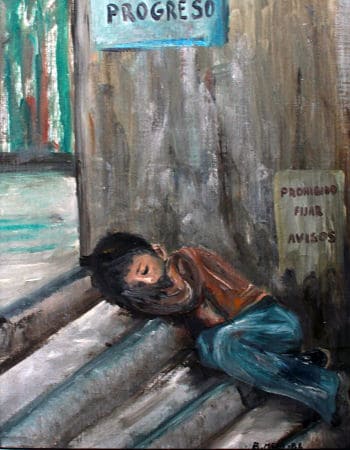
As I prepare to join the other MMTW artists in Berlin, I recall those years. The image of the Berlin Wall as a symbol of history and division of the world, guarded by intimidating security apparatus, returns to me. Thinking of “The Wall” and its heavy and constant surveillance, which extended far beyond the wall itself and permeated society in the East, took me back to the anxiety of my childhood when “walls had eyes” and I was under the intimidating watching presence of an omnipresent higher power. These thoughts inspired some of the paintings I will display at the Kapelle der Versöhnung (Chapel of Reconciliation) at the Wall Monument in Berlin.
The Chapel of the Reconciliation is a place I have visited many times; a place where I have found inspiration and inner reconciliation. Its inner walls are heavy and textured; to me they represent the heavy layers of time and human endurance, and resilience. I created pieces inspired in the Kapelle and its setting in the former “no man’s land” for the exhibition. I used canvas and paint and construction materials, along with soil, which for me is a metaphor for the migration journey (I bring the ground and the walls along with me when I move). While Germany has remained a very important place in my life, it was not my destiny to remain there. I moved on many times, settling in Mexico, the USA and Colombia at different points in time. I have lived in four different countries and learned three languages. I have come to be at ease navigating new social systems and coping with different cultures. I have seen how the labyrinths that each new place appears to be on arrival become the walls of my home. Walls are not always concrete – they are often immaterial.

Migration and displacement have been themes in my art for many years. In the past my art often explored migration as fragmentation and being torn between two places. But in fact, I was not “between” but among several homes: and I moved among “my” four countries several different times. When I read Susan Ossman’s book Moving Matters: Paths of Serial Migration, I found the concept of serial migration she proposed “solved” many problems I had encountered trying to think about my own life. Participation in the different chapters of the MMTW has helped me to develop not only new concepts, but metaphors and practices that correspond to my path and the world as those of us in the MMTW see and experience the world.
Working in response to Susan’s writing led me to redefine myself as a serial migrant. It offered me some guiding images and ways of thinking that led me to embody and represent my life in art. Being involved with others in projects I learn about humanity through “my own eyes” and I free myself from my own preconceptions. The MMTW also gave me license to try new kinds of work. I am mainly a visual artist, not a performer. But with the MMTW I feel support to explore performance as a new form of research and expression. I read anthropology and philosophy. I contribute to scenarios for collaborative performances and sometimes play music on stage. I feel free to become the performer the group needs and wants me to be, and also the performer that is already inside me clamoring for expression. With the collective support of the others, I become ready to fulfill the expectation that I can create a strong connection with the audience.
Mi Tiempo, Mein Raum, My Map is a good example of how the MMTW changed my art. For the first meeting of the MMTW in Riverside, California 2013, the artists and writers worked directly with parts of Susan’s book to shape our interventions. I was especially inspired by these passages:
“While some serial migrants use their birthplace as a ribbon to tie their lives together, others have seen history erase their birthplace from the map. States disappear. Borders shift. Hometowns are joined to new countries.” (34)
“…without mention of love no account of migratory desire could be accurate or complete.” (129)
“…wisps of affection and questions of memory tied to place through particular people.” (143)
In the performance, I literally use a red ribbon to tie up my life. I walk on a canvas on which I have written the names of all of the people I’ve met during my life; at least as many as I can remember. The process of recollection while drawing the canvas helped me to understand the interconnections of my path. Reading the names aloud rephrases my journey. I draw my path with the red ribbon across the canvas of names. I begin with the girl Beatriz growing up in a close family circle in Columbia. The red ribbon trails Beatriz as she follows her love, Peter, to Germany, then returns to Colombia, travels again to Germany, then moves between the USA and Mexico.
Performing for very different audiences brought out different aspects of the story, of the places evoked by the names, and of myself. For instance, in Clichy, France, the audience was very attentive and the gilded and mirror-filled space was really inspiring. Perhaps working with artists like Erith Jaffe-Berg who comfortably performs in several languages and includes the nonsense “gromolo” of the commedia dell’arte also made me feel freer. I included dance and loosened up to tell something about the story of each name in the way I read, sung or whispered each name.
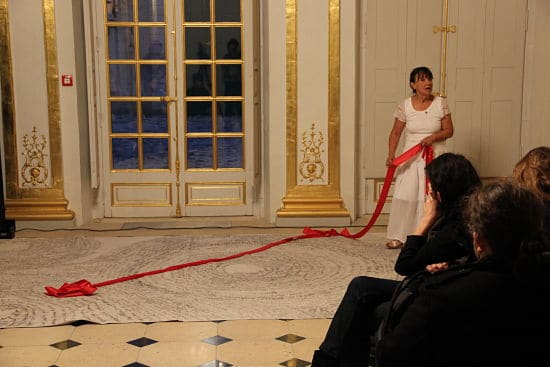
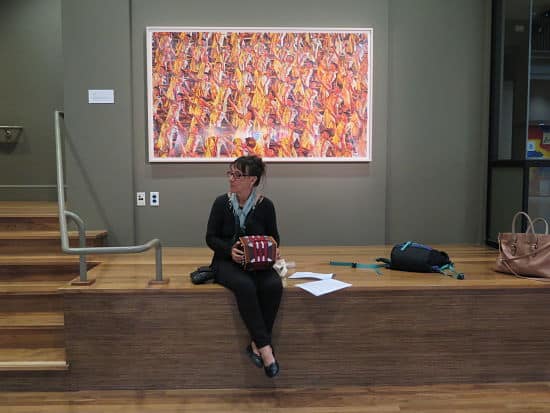
As Susan noted in an interview with Hellen Faller for Allegra Lab, we serial migrants have a lot in common. Over time the MMTW has become a community on the move. In the interval between meetings I work on ideas sparked by the workshop. Sometimes I feel like the MMTW is in my studio, helping me to take risks and move further with my work. Artists in the group often exchange thoughts on-line or meet informally. I have not been able to attend every MMTW workshop, but when I cannot be there in person, I send my work to “participate” in my place. We move together. We always have a next project on which to focus our efforts; like the serial migrant individually, the group always has a potential ‘next place’ in its consciousness.
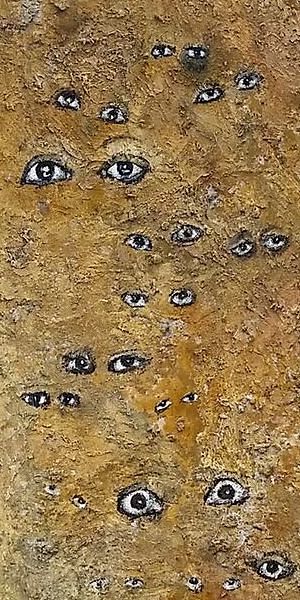
Working with the MMTW for four years has led me to be more conceptual and abstract. From representing the entire human figure, I’ve moved to tracing trajectories and contemplating connections. In the pieces for MMTW Berlin it is as though the bodies have melted to become a “wall”: only the sets of eyes remain individualized; they are expressive and watchful.
The fall of the Berlin Wall in 1989 marked a historical moment of solidarity and showed the power to overcome oppression. Sadly, many other walls of separation are being erected around the World. This inspires me to convey my strong desire to dwell among walls of inclusion and support. The freedom of becoming also requires making walls; walls for inner protection designed to foster attachments. When I am invited into a home or activity I feel included, I want to get closer to others.
Walls have given me peace, comfort, and security. Walls have offered me warmth. They have helped me to conceal secrets about my pain and sorrow. They have been like frames for joyful moments. Walls have eyes to observe but their “eyes” can also communicate acceptance, care and love.

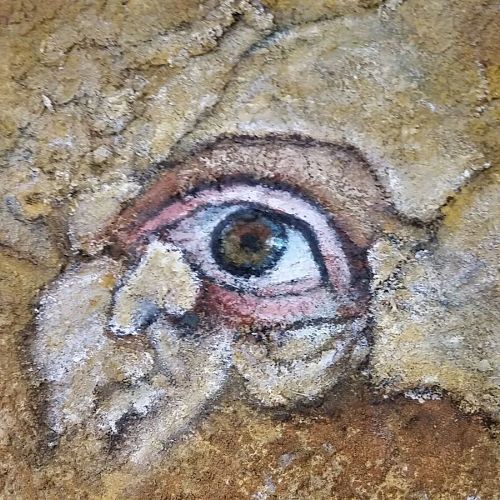




Worth looking at: Tim Ingold’s The Perception of the Environment: Essays on Livelihood, Dwelling and Skill (2000).
Great article!! Proud to have you as my friend! Wishing you great success in Berlin